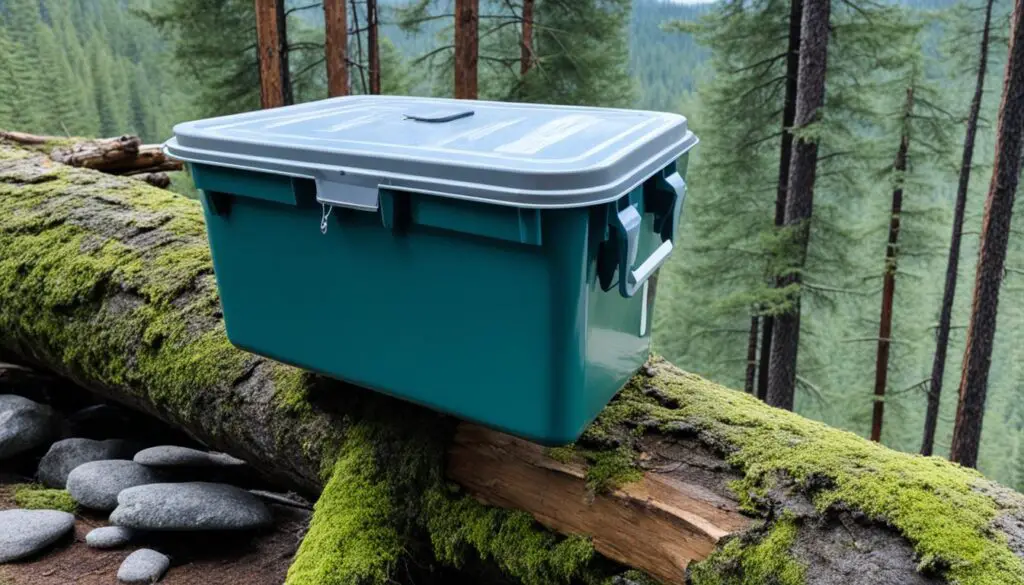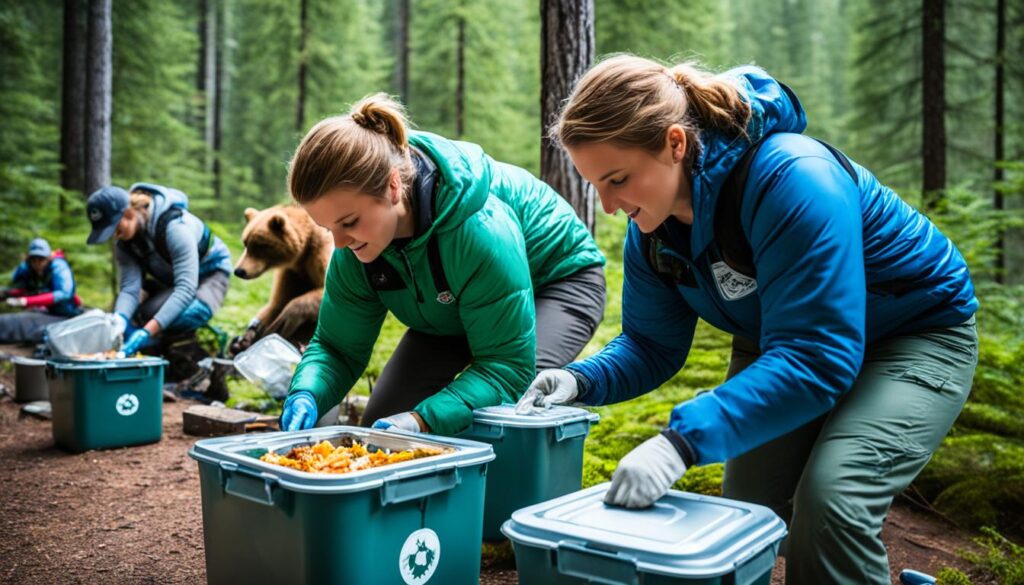Prevent Bears While Camping
This guide will help you prevent bear encounters while camping. We’ll discuss bear behavior, taking the right precautions, and keeping food and waste from attracting bears. It doesn’t matter if you’re new to camping or have lots of experience. This guide gives you the knowledge and confidence to camp safely where bears live.
The risk of a bear attack in the lower-48 is very low over the last 20 years. Only a few bear attack deaths have been reported. Statistically speaking, it’s much more likely to be struck by lightning than to be attacked by a bear. And your chances are higher to win the Powerball than to have a bear attack. Yet, running into bears while camping is more common. So, it’s important to be prepared for bear encounters.
Even though the risk of a bear attack is low, understanding bear behavior and their habitats is key. This helps prevent dangerous situations. By following safety steps and keeping your campsite free from bear attractants, you can camp worry-free. Enjoy the outdoors without the fear of bear encounters.
In the next parts, we’ll talk more about bears in the wild, what draws them to campsites, and key steps to avoid them. Let’s make sure you have a safe and fun time on your outdoor adventure.
Understanding Bear Behavior and Habitat
To safely enjoy the great outdoors, it’s crucial to know about bears. In the U.S., there are mainly two bear types: the black bear and the grizzly bear.
Each bear has its specific features, where they like to live, and how they act. These things affect how they might behave around people out in the wild.
Types of Bears Found in the Wilderness
Black bears live all across North America, from forests to cities. They’re smaller and quicker than grizzlies. They eat things like berries, nuts, and even small animals. Usually, they aren’t too aggressive, but they can get bold if they find food near people.
On the other hand, grizzly bears stick to the western U.S., mostly in wild, mountain areas. They are bigger and have a hump on their back. Grizzlies eat plants, fish, and dead animals. They are more likely to be bossy and protect their area, making them quite a sight in the wild.
Factors That Attract Bears to Campsites
It’s important to know what makes bears come close to camp. They love easily available food, smells, and even people’s waste. Their noses can sniff out cooking or trash, which makes them come over for a meal. Also, places where many people hang around might look like easy food to bears.
| Factor | Explanation |
|---|---|
| Food Sources | Bears find badly kept food, scraps, and even human waste as food sources. |
| Scented Items | With their strong smell, bears notice cooking, personal products, and other scents. This can attract them to campsites. |
| Human Activity | If they see a lot of human activity, bears might think there’s food or they’re easier to catch there. |
Knowing about bear types and what attracts them is key to staying safe in the wild. It helps avoid dangerous bear encounters and makes your camping trip fun and worry-free.
Essential Precautions to Take Before Camping
Before going into the wild, take key steps to lower the chances of meeting a bear. Look into bear activity where you’ll camp and bring the right food storage to keep bears out.
Researching Bear Activity in Your Camping Area
Start by learning about bear activity where you’ll be. This helps you know what to look out for and prepares you. Talk to park rangers or search online for info on recent bear sightings or known bear habits in the area. This way, you can choose a safe spot for your tent, food, and gear.
Packing Bear-Proof Food Storage Containers
It’s important to keep your food safe from bears. Use food containers that bears can’t break into. These containers should be strong and maybe even lockable. Also, get any tools you need, like carabiners and ropes, to hang your food in a tree.
If you check out bear habits and bring the right food containers, you can avoid surprise bear visits. This will make your nature trip both safer and more fun.

| Precaution | Description |
|---|---|
| Researching Bear Activity | Gathering information on recent bear sightings, incidents, and travel patterns in the camping area to understand potential threats and guide your preparations. |
| Packing Bear-Proof Food Storage | Investing in high-quality, bear-proof food storage containers and equipment to effectively secure your food and scented items away from your campsite. |
Prevent Bears While Camping
Once you’re at the campsite, do things to keep bears away. Use bear-safe camping practices to cut the chance of a bear encounter. This way, you’ll have a safe and fun time.
Choosing the right spot is key. Pick a bear-proof campsite far from bear hangouts like trails or berry spots. A place with less thick plants, and away from water and food, is best.
Keeping your site clean matters a lot, too. Store food and smelly items well. Also, keep meals areas clean and get rid of trash the right way. This stops bears from looking for food at your camp.
- Store all food, including pet food, in bear-proof containers or hang it from a tree at least 10 feet off the ground and 4 feet from the tree trunk.
- Avoid cooking or eating near your tent, and keep a clean campsite by regularly removing any food scraps or spills.
- Properly dispose of all garbage and food waste in designated bear-proof containers or by burning it in a campfire.
Stay smart and watchful around your camp. Don’t leave food out and be careful. If you see a bear, stay calm. Don’t go near it, and back off slowly to safety.
| Campsite Selection | Campsite Maintenance | Daily Activities |
|---|---|---|
| Avoid areas with known bear activity | Keep a tidy, organized campsite | Remain alert for signs of bear activity |
| Choose an open, vegetation-free location | Properly store and secure food and scented items | Avoid leaving food or scented items unattended |
| Position campsite at least 100 yards from water sources and food storage areas | Regularly clean cooking areas and dispose of waste properly | Keep a safe distance from any bears you may encounter |
Follow these bear-safe camping practices closely. You’ll lessen the chance of meeting a bear. Instead, enjoy a calm, bear-proof campsite on your trip.
Proper Food Storage and Waste Management
When camping in bear country, it’s key to store your food right. Proper waste management also matters a lot. They both help keep you and the bears safe during your trip.
Techniques for Securing Food and Scented Items
For bear-proof food storage, move any food and smelly items from your camp. Use bear-resistant containers or hang them high. Keep them 10 feet up and 4 feet away from tree trunks.
- Use rigid plastic or metal bear-proof containers designed for camping
- Suspend food, toiletries, and scented items in a bear bag or bear hang at least 10 feet off the ground and 4 feet from the tree trunk
- Store all food and scented items away from your tent and cooking area
Disposing of Waste Properly to Avoid Attracting Bears
Getting rid of trash and food scraps right is as vital as storing food well. Throw scraps and wrappers in bear-proof trash cans. Or, take them away with you. Don’t leave any trash behind, or it will invite bears to your area.
- Pack out all trash, food scraps, and waste from your campsite
- Use bear-proof trash cans or dumpsters when available
- Bury human waste and toilet paper at least 6 inches deep and 200 feet from your campsite, trails, and water sources
Following these tips for bear-proof food storage and proper waste disposal will lower your bear risk. You can then have a great, bear-safe time outdoors.
Conclusion
To avoid bear problems when camping, we need a good plan. This involves getting to know how bears act, being careful, and setting up the right food and trash plans. With these steps, I can safely have fun outside in places where bears live. Being ready and showing respect for bears’ homes is crucial for a fun camping trip.
To keep bears away, remember to place food and cooking stuff far from where you sleep. Also, hang food away from bears, make noise to let them know you’re there, and never feed them. Bear spray and air horns help too. Keep your sleeping and eating spots apart and camp in safe areas to lower the chance of meeting a bear. Plus, avoid using things that smell strong.
By sticking to these tips for staying safe in bear zones and having fun responsibly, my camping trips will be great. The main thing is to be ready, care for the outdoors, and do what we can to live peacefully with the animals. This way, we can enjoy the beauty of nature without worry.
FAQ
What are the most common bear species found in the wilderness?
In North America, the black bear and the grizzly bear are common. They have different traits and behaviors. These can affect how they interact with people.
What factors can attract bears to a campsite?
Bears are drawn to campsites by smells, food, and what they see people doing. Safe food storage and clean campsites are key to keeping bears away.
How can I research bear activity in the area I plan to camp?
Before going camping, learn about bears in the area and any dangers. Knowing about bear activity will help you prepare and stay safe.
What types of bear-proof food storage containers should I use?
Choose the right bear-proof containers and gear for your food and smells. This will help keep bears from your camp.
How can I properly dispose of waste to avoid attracting bears?
Get rid of all trash and food scraps carefully. This is vital to avoid luring bears to your camp. Follow the right steps for waste management.
What are the best practices for maintaining a bear-proof campsite?
When picking a campsite, select it wisely. Keep your place clean and organized. Stay alert everyday to lessen your chance of seeing a bear.
